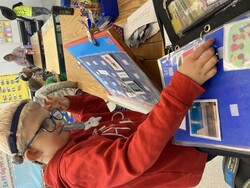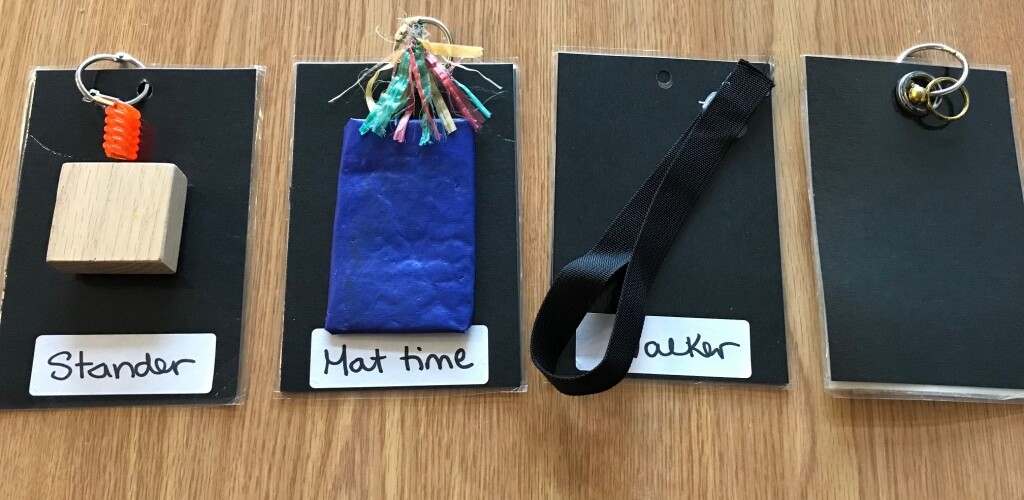Calendar Systems

A calendar system is any system that helps us to divide time into manageable chunks.
For students who are deafblind, calendar systems can range from simple systems that help the student understand what activity is happening right now and when that activity is finished to weekly, monthly, and yearly calendars.
Calendar systems for students who are deafblind are specifically designed to be accessible to the student and build on communication skills, concept development, and emotional wellbeing.
Calendars provide a structure for meaningful communication between the student and others.
Calendars provide:
- Someone for the student to communicate with.
- Something to communicate about - calendars can help set the topic of conversation so it is clear for both people.
- Consistent, routine opportunities to communicate.
- A reason to communicate.
- Multiple forms - static and dynamic forms of communication.
Human beings have a desire to understand, structure, and manage their time. From natural cues like the sun rising and setting to huge cultural systems like the Gregorian calendar, people have always divided time into sections to make it easier to manage.
Schools are full of systems to manage time. A bell system divides the day into manageable chunks and keeps the whole school working together. Daily schedules are posted in classrooms, hung in lockers, and pasted in binders. Students are taught often taught to use agendas starting in kindergarten.
When we leave school, we become more responsible for our own systems. For example, a shared calendar to manage family activities, reminders on a phone to cue us to complete a task, a wall calendar to keep track of birthdays, and so on.
For students who are deafblind, many of the previously listed systems are not accessible. In addition, they may not be able to observe other people using these systems and so may be unaware that they even exist.
Students who are deafblind need specially designed time management systems that are accessible to them and directly teach time concepts.
Creating a Calendar System
It is important to work with your POPDB teacher consultant and the rest of the student's team when creating and introducing a calendar system. There are many thing to consider when planning a calendar system.
Type of Calendar
Determine the type of calendar system will best meet the needs of the student. Does the student need support to understand what is happen in the present moment? If so, an anticipation calendar may be the most meaningful. Does the student want to know more about what is happening later in the day? A daily calendar may be the most useful for that student.
Forms
Determine which static forms will be accessible and motivating for the student. Does the student enjoy looking at themselves in photographs? Does the student recognize objects while participating in a routine? Would print or braille be appropriate? Looking at the student's current abilities and preferences can help determine what forms to start with.
Format
Determine the format of the calendar. The calendar must have some way to put time into chunks. For example, baskets to hold objects or a strip with clearly defined sections. The calendar should have some way to indicate when an activity is completed.
Location
The location of the calendar should be accessible to the student. Does the student need a calendar that is portable or is it better for the student to have a consistent location for the calendar routine? If the calendar will be portable, where will materials be stored?
Frequently Asked Questions
The calendar system is an essential part of a learner who is deafblind's day. The purpose of the calendar goes beyond simply letting a student know what is happening next. Calendars drive concept and language development. They provide the information that the student needs to feel safe so they can be available for learning.
Building an effective calendar system requires time, commitment, and consistency. To make the system meaningful for the student, the Intervenor must take time to actively involve the student in setting up and using the calendar. Each visit to the calendar is an opportunity to work on communication and concept development. It is time well spent for the student who is deafblind.
Many people use some sort of calendar system to keep track of appointments, routines, meetings, and special events. Students with deafblindness also need ways to keep track of the events that are important to them. There is security and comfort in having a schedule available especially, when you are not able to see or hear what is happening around you.
One important function of a calendar systems is helping students to understand changes in their routines. For example, if a preferred activity is cancelled, discussing the change in routine and offering an alternative before it happens can help relieve a lot of stress for students.
The power of the calendar system is that is used for language and concept development, not just scheduling. Consider if the student you are supporting would benefit from expanding their calendar system to make it more complex and work on additional concepts. For example, adding a weekly calendar to the student's existing daily schedule.
The calendar system and the cues are the learner's way of communicating and can only be changed through careful planning. How can we expect the person to become expressive when we keep changing their words? It would be like having someone decide that this month, we are all going to speak French and next month it will be Russian. A student with deafblindness needs to have consistency with their communication system.
That doesn't mean we can never make changes. Changes need to be made with the student over time, so they are an integral part in creating new cues/signs/gestures.
It may be time to think about developping a more portable system. By reducing the size of the cues and calendar system, it makes it easier to take them with you.
Remember that changes need to be made WITH the student over time, so they are part of creating the new calendar system routine.
Consider the type of calendar you are using. Is it accessible to the student? Are the symbols meaningful for the student in the routine they are representing? Is the type of calendar you are using appropriate for the student? Is the calendar being used consistently? Ask your POPDB teacher if you have questions.
For many students who are deafblind, the calendar is their first exposure to an organized, accessible form of static communication. It will take time for them to learn how to use it effectively. The best way we can help them learn is by consistently taking the time to involve them in the calendar routine.
Calendar systems for students who are proficient communicators (those who have language skills at or near the level of their peers) may look different from the calendars mentioned above. They may look more like standard systems and use print, braille, or be accessed electronically. It is still important to directly teach students who are deafblind and proficient communicators how to effectively manage their time and schedules.
Students who are proficient communicators may have gaps in their conceptual understanding of time, time management, and scheduling. They may miss information such as reminders written on the board or announcements made by the teacher. Setting aside a little bit of time each day to discuss the student’s schedule and upcoming events can provide an opportunity for the student to ask questions and get clarification. Intervenors can provide direct instruction about concepts as they arise so that students can continue to take on appropriate responsibilities for their time and time management.
